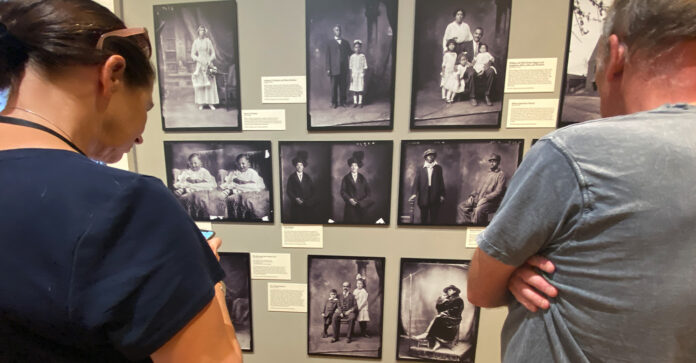
By Sydney Shuler, The Daily Progress
During the Jim Crow era, when minstrel shows and racist caricatures accounted for nearly all visual representations of Black people, hundreds of Black Virginians from Charlottesville, Albemarle County and Nelson County commissioned distinguished self-portraits that shattered stereotypes.
The Holsinger Collection exhibit, titled Visions of Progress: Portraits of Dignity, Style and Racial Uplift featuring photographs taken by well-known Charlottesville photographer Rufus Holsinger, will be on display at the University of Virginia Albert and Shirley Small Collections Library through September 2023.
The collection has the power to change the historical narrative of Black life in Central Virginia during the 19th and early 20th century. The subjects in each portrait commissioned the photos from the University Studio, which was on West Main Street where Mel’s Cafe is now located.
According to a brochure written by the organizers of The Holsinger Portrait Project, there is no evidence that Holsinger himself was a racial liberal. In fact, as a member of the Charlottesville City Council, he supported an ordinance that segregated residential areas.
“We’ve spent a lot of time learning about what the statues of Robert E. Lee and Stonewall Jackson meant and the messages that they sent in support of white supremacy. We haven’t spent very much time learning about what the Black folks were doing,” said John Edwin Mason, a UVa professor of African history and the history of photography.
Mason is the director of the Holsinger Portrait Project.
“This exhibition is all about how Black folks not only survived, but how they, in some ways, morally and psychologically prospered during that time,” Mason said.
The entire studio collection, also stored at the Small Collections Library, includes 10,000 images with 611 portraits of Black subjects. Most of the images in the collection include names and details about who those people were, but the names were determined by who paid for the photoshoot rather than who is in the photos.
The contents of each portrait are unique. Some are of individuals. Some feature family units. Some include photo subjects in traditional early 20th Century formal clothing and others show people dressed in the latest fashions. But each contributes to the variety and diversity of Black Central Virginians at the time.
Modern-day portraits have become a habit for most school children and employees, but the images in the Holsinger Collection were a symbol of resistance to racial oppression and harmful stereotypes.
Although the portraits were taken during a time of tremendous racial injustice and violence, the people in them do not look like what they have been through.
During the early 20th century, job options for Black women were overwhelmingly confined to domestic servant positions, while most Black men worked in hard labor industries. In contrast with the other imagery of Black blue collar employees in the early 1900s, the Holsinger Collection portraits do not feature Black people in soiled work clothes.
“We know that when people imagine what African Americans looked like over 100 years ago in Central Virginia, they do not imagine these beautiful portraits of style and panache,” Mason said.
“They weren’t defined by their oppression. They weren’t defined by their jobs as housemaids or janitors. They were defined by their personal dignity and their conviction that they were equal to anybody else and deserve the full rights to citizenship.”
The research that led to the establishment of The Holsinger Portrait Project began near the end of 20th century. That’s when the late Reginald Butler, a former UVa history professor, and Scott French, the former associate director of the Carter G. Woodson Institute, mounted a small exhibition of portraits from the collection.
That display sparked the idea for The Holsinger Portrait Project, Mason says. That vision finally came to life in 2019 during the first Family Photo Day hosted by the Holsinger Studio at the Jefferson School in an effort to identify some of the photo subjects yet to be named.
The event was a chance to “connect the photographs and names of the past with the ongoing story of African Americans in the Charlottesville region,” according to the Holsinger Studio website.
Families are invited to view images in the collection and even bring family photos of their own, which could also help the studio’s search for lost names.
Family Photo Day set the precedent for The Holsinger Portrait Project’s mission to educate the Charlottesville, Albemarle County, Nelson County and Virginia communities about an untapped area of Black history.
After the exhibition opening, The Holsinger Portrait Project will go on tour around Virginia, starting with primary and secondary schools. It will use 500 images from the collection to educate young Virginians about the reality, prosperity and hope of the Black people in each image.


